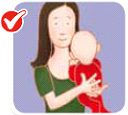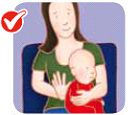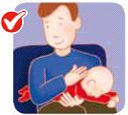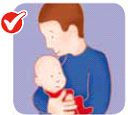Winding techniques
Winding is a necessary part of feeding an infant. It is normal for infants to experience windy symptoms to some extent in the first few months of life. The reason infants are particularly windy is because infants are likely to swallow air during their milk feed and may even swallow some air while crying and even breathing.
The air fills an infant’s stomach, which can make them feel uncomfortable and quite full before they have had enough milk to drink. While a little trapped wind will not cause any harm to an infant, too much wind will cause an infant to feel uncomfortable and they may stop sucking their feed and cry.
Breastfed infants control the flow of milk more easily. If bottlefeeding, one can minimise the amount of air taken in during feeding by tilting the bottle to ensure that the milk fills the teat, and also by encouraging to feed the infant in an upright or near-upright position.
Different winding techniques will suit different infants and each infant will differ in how easily they bring up their feed. Some infants need to be winded during their feed while others only need to be winded at that end of every feed. It is important for parents and healthcare professionals to experiment and find what technique suits the infant the best.
Most popular winding techniques for parents
- Parents should place the infant over their shoulder with the infant’s body supported by their arm. The infant should be in an upright, stretched out posture. Parents should pat or rub the infants back with their other hand.
- The infant can be placed upright on the parent’s lap, supported by cupping the infants chin gently with their hand and body with their arm. The infant should be allowed to lean forward slightly, so that their tummy rests against the parent’s arm. This position will gently compress their abdomen which may help to bring up the wind. Parents should pat or rub their back and sides with their other hand.
- The infant can be placed face down on parent’s lap. Held firmly with one hand while patting or rubbing their back and sides gently with the other.
- At the end of the feeding session, parents can cuddle their infant close and they may get a sleepy burp in response!
As an infant develops, and starts getting active (e.g. rolling or crawling), they will find it easier to bring up wind. This varies for each infant, but for some, they may need a little help after feeds.




Tips for reducing wind in bottlefed infants
- Parents should keep the infant in an upright position during and after feeding.
- Make sure mouth covers the whole teat during feeding.
- Smaller feeds should be offered more frequently
- Parents should ensure the correct teat size is being used. If the infant is using an incorrect teat size and feeds are taken too slowly or too quickly, the amount of air swallowed may increase.
Winding Techniques for Parents
Help us provide information most relevant to you
Please ensure your role and areas of interest are up to date.
